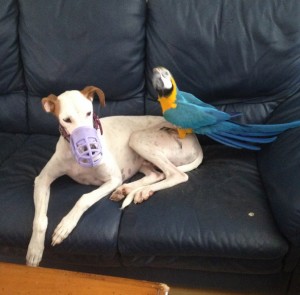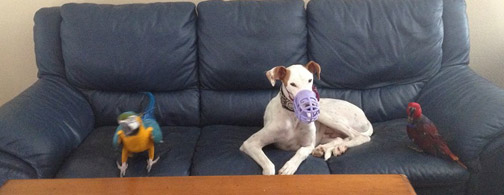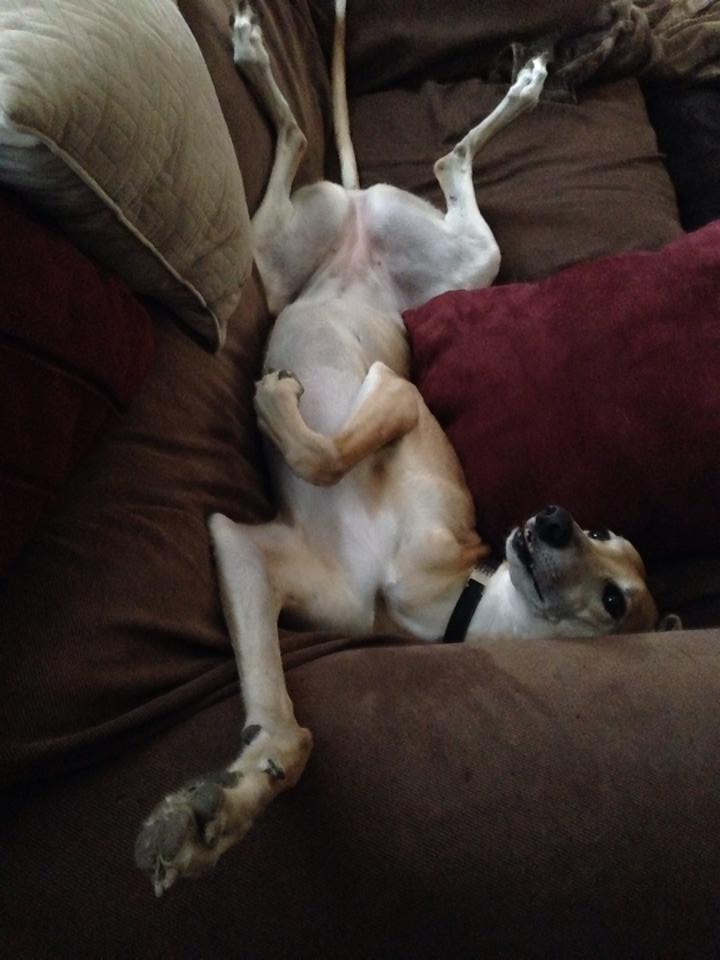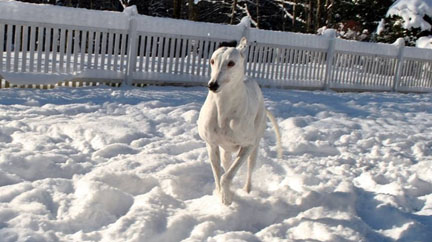Retired racing Greyhound John – also known as St. John for his high tolerance for fosters – is one of the personal dogs of SHUG Director, Michael Owens. He is a mellow senior who is cat-safe, puppy-safe, and kid-safe. John is practically perfect in every way . . . as long as you aren't a bird.
The sweet little finches came from her daughter's classroom. They were secured behind a gate and enclosed in a sturdy cage suspended from the ceiling, almost 6’ off the ground. John says they tasted just like chicken nuggets. Let us take a moment of silence for these innocent lives . . . and cue the emergency trip to Petsmart.
 SHUG adopter Lara Goldfarb had been down a similar road and has learned this lesson well. When her family recently adopted a Galgo named Luke, she knew training and precautions were in order to protect Goldie, a rescued blue and gold macaw, and Lucia, a female Eclectus.
SHUG adopter Lara Goldfarb had been down a similar road and has learned this lesson well. When her family recently adopted a Galgo named Luke, she knew training and precautions were in order to protect Goldie, a rescued blue and gold macaw, and Lucia, a female Eclectus.
Here are some Q&As with Lara on how to “bird proof” your dog.
How are you introducing them to Luke?
I’ve done a lot of research on interspecies dog introduction, although at first I didn’t get much help. One greyhound rescue I asked said they had no clue. Neither did many other Sighthound people I asked. Many people just generally thought it was a bad idea to mix. Most of the information on cat-to-dog introduction is just not helpful for parrots. I finally uncovered one article that suggested keeping the bird very still, which makes sense. A bird in flight is sure to entice a Sighthound! So for awhile I keep the birds near the dog very still and at the dog's level. If the dog wants to sniff, while muzzled, that's ok with me. I also want the dog to see the bird moving around in its five-foot wrought iron cage. I want to see if the dog is more interested in the food the bird drops than the bird itself. I also want the dog to watch me interact with the parrots.
After about two weeks of this type of general very controlled interaction, I let the parrots hang out on their giant tree stands while the dog is muzzled but free roaming in the room. The birds cannot fly as their wing feathers are clipped. But, a parrot who wants off the stand will flutter down to the ground and walk around. I can't predict when that will happen. The dog will almost always investigate and follow. I allow the dog to be curious while following in reach of the dog. I will continue to do it this way for several months before deciding what the next step will be. It depends on the dog. And of course, the dog knows it is muzzled and once that muzzle is removed, an adult dog may be unpredictable. There are no guarantees.
How is it going so far?
For an adult dog, I think it is going well. Since the Galgo is not as acclimated to the use of a muzzle as a grey, I have to wonder when the time will be right to try it without a muzzle or if freedom will change his mind on a fast moving bird. He seems indifferent to the birds on the stands or in the cages. Good start! When they flap their wings, he is curious but he has not snapped. Another good sign.
What are you looking for to indicate things are not going well?
A tense dog. Heightened interest and a refusal to break focus on the parrot. Being more interested in the parrots than the food they are continually throwing everywhere. Sighthounds tend to have a loud snap. Even while muzzled, you can hear that.
What is your ultimate goal?
To be able to have Luke free roaming around the parrots without a muzzle. I feel bad using a muzzle.
What tips can you offer to others with birds?
Go slow. No rush. Use muzzles, crates, leashes and gates, whatever you reasonably need. Be present and be on constant guard to read the dog's body language. But just remember, the true test with a Sighthound comes with the rapid movement of the bird in flight. And when that time comes, I promise you that your dog is faster than your reflexes. And don't depend on articles relating to cat introductions. A flightless parrot cannot escape from the dog the way a cat can.



Update 6 + years later. The bird thing didn’t work out with Luke. He was re-adopted by me in Nov. 2014. Funny, he always lunged at crows on the ground or other small birds that might fly by in his path while walking.
Luke went to the Rainbow Bridge in January 2021. RIP Luke. You left us too early. Love and miss you dearly!!